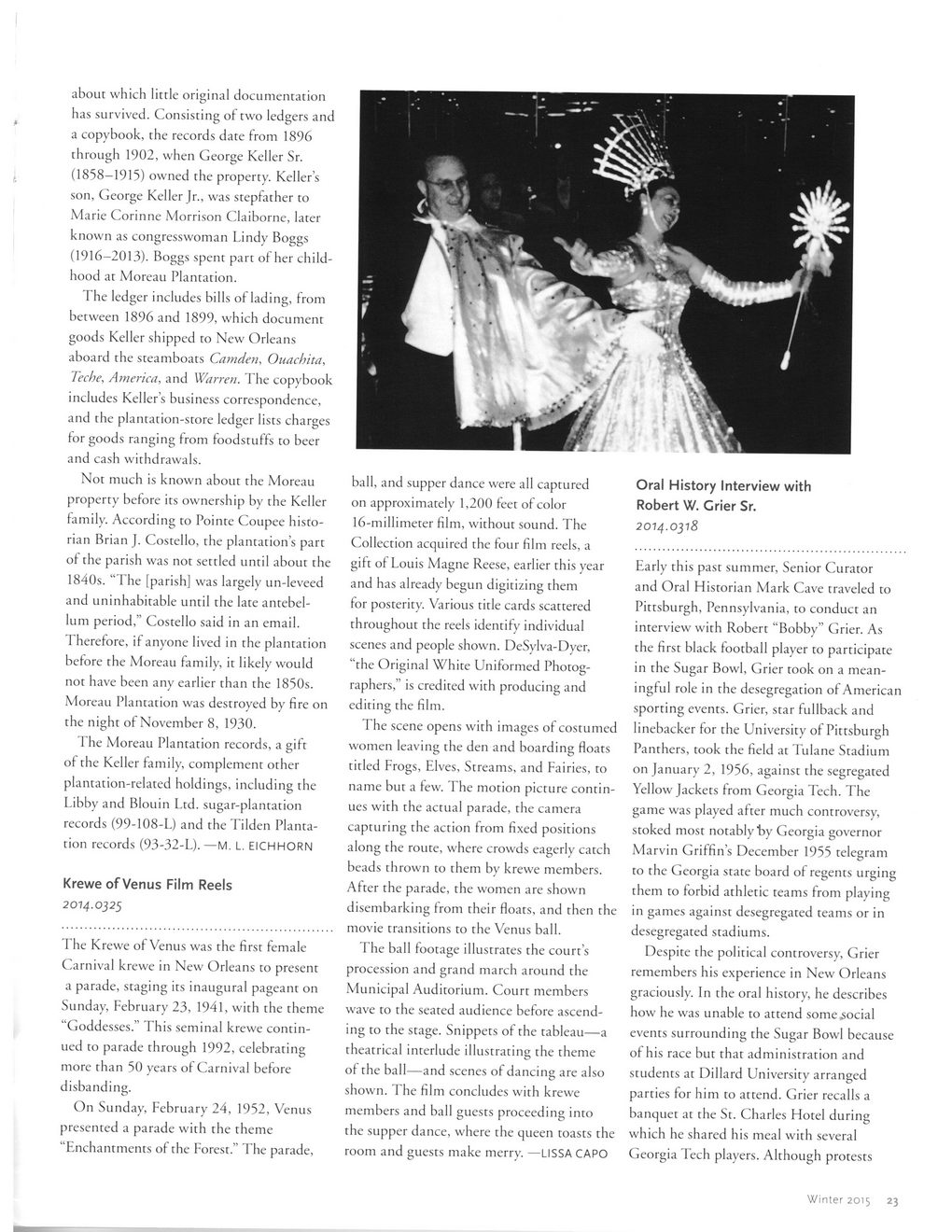This text was obtained via automated optical character recognition.
It has not been edited and may therefore contain several errors.
about which little original documentation has survived. Consisting of two ledgers and a copybook, the records date from 1896 through 1902, when George Keller Sr. (1858-1915) owned the property. Keller’s son, George Keller Jr., was stepfather to Marie Corinne Morrison Claiborne, later known as congresswoman Lindy Boggs (1916-2013). Boggs spent part of her childhood at Moreau Plantation. The ledger includes bills ot lading, from between 1896 and 1899, which document goods Keller shipped to New Orleans aboard the steamboats Camden, Ouachita, Teche, America, and Warren. The copybook includes Keller’s business correspondence, and the plantation-store ledger lists charges for goods ranging from foodstuffs to beer and cash withdrawals. Not much is known about the Moreau property before its ownership by the Keller family. According to Pointe Coupee historian Brian J. Costello, the plantation’s part of the parish was not settled until about the 1840s. “The [parish] was largely un-leveed and uninhabitable until the late antebellum period,” Costello said in an email. Therefore, if anyone lived in the plantation before the Moreau family, it likely would not have been any earlier than the 1850s. Moreau Plantation was destroyed by fire on the night of November 8, 1930. 1 he Moreau Plantation records, a gift of the Keller family, complement other plantation-related holdings, including the Libby and Blouin Ltd. sugar-plantation records (99-108-L) and the Tilden Plantation records (93-32-L). —M. L. EICHHORN Krewe of Venus Film Reels 2014.0325 The Krewe of Venus was the first female Carnival krewe in New Orleans to present a parade, staging its inaugural pageant on Sunday, February 23, 1941, with the theme “Goddesses.” This seminal krewe continued to parade through 1992, celebrating more than 50 years of Carnival before disbanding. On Sunday, February 24, 1952, Venus presented a parade with the theme “Enchantments of the Forest.” The parade, ball, and supper dance were all captured on approximately 1,200 feet of color 16-millimeter film, without sound. The Collection acquired the four film reels, a gift of Louis Magne Reese, earlier this year and has already begun digitizing them for posterity. Various title cards scattered throughout the reels identify individual scenes and people shown. DeSvlva-Dyer, “the Original White Uniformed Photographers,” is credited with producing and editing the film. The scene opens with images of costumed women leaving the den and boarding floats titled Frogs, Elves, Streams, and Fairies, to name but a few. The motion picture continues with the actual parade, the camera capturing the action from fixed positions along the route, where crowds eagerly catch beads thrown to them by krewe members. After the parade, the women are shown disembarking from their floats, and then the movie transitions to the Venus ball. The ball footage illustrates the court’s procession and grand march around the Municipal Auditorium. Court members wave to the seated audience before ascending to the stage. Snippets of the tableau—a theatrical interlude illustrating the theme of the ball—and scenes of dancing are also shown. The film concludes with krewe members and ball guests proceeding into the supper dance, where the queen toasts the room and guests make merry. —LISSA CAPO Oral History Interview with Robert W. Crier Sr. 2014.0318 Early this past summer, Senior Curator and Oral Historian Mark Cave traveled to Pittsburgh, Pennsylvania, to conduct an interview with Robert “Bobby” Grier. As the first black football player to participate in the Sugar Bowl, Grier took on a meaningful role in the desegregation of American sporting events. Grier, star fullback and linebacker for the University of Pittsburgh Panthers, took the field at Tulane Stadium on January 2, 1956, against the segregated Yellow Jackets from Georgia Tech. The game was played after much controversy, stoked most notably by Georgia governor Marvin Griffin’s December 1955 telegram to the Georgia state board of regents urging them to forbid athletic teams from playing in games against desegregated teams or in desegregated stadiums. Despite the political controversy, Grier remembers his experience in New Orleans graciously. In the oral history, he describes how he was unable to attend some social events surrounding the Sugar Bowl because of his race but that administration and students at Dillard University arranged parties for him to attend. Grier recalls a banquet at the St. Charles Hotel during which he shared his meal with several Georgia Tech players. Although protests Winter 2015 23

New Orleans Quarterly 2015 Winter (25)